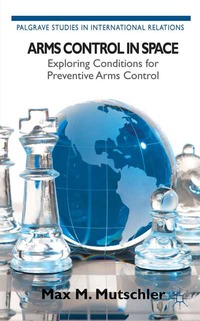Review: Arms Control in Spaceby Jeff Foust
|
| Mutschler’s thesis is that effective arms control, be it in space or on the Earth, requires addressing three key variables: interest, power, and knowledge. |
Given that most governments and organizations understand the hazards posed by using weapons in space, most notably the production of debris that could make some orbits unusable by any satellite, why is it so difficult to come up with treaties or other accords to prohibit or otherwise limit their use? That’s the issue examined by Max Mutschler of the German Institute for International and Security Affairs in Arms Control in Space, an academic review of the topic.
Mutschler’s thesis is that effective arms control, be it in space or on the Earth, requires addressing three key variables: interest, power, and knowledge. Countries have to be in a position of recognizing the benefits of cooperating over an arms race, develop accords that allow for balanced gains among the participants, and have a means for verification. He uses as an analogy the effort to establish the ABM Treaty in the 1960s and 1970s, after the United States and the Soviet Union recognized that the costs and risks of anti-ballistic missile systems outweighed any benefits, and developed processes to limit the testing and deployment of such systems. That can be a model, he argues, for the development of similar agreements restricting space weapons.
A major challenge for any accord involving weapons in space is determining what, exactly, should be included. Mutschler uses the term “space weapons” a number of times in the book before making an effort to define it: any device, regardless of where it is based, that is designed to damage or destroy an object in orbit, or a space-based weapon designed to attack targets on Earth. That is, in many respects, a common-sense definition, although arguably the real concern today is not with weapons in space attacking the Earth than with the use of weapons in space, creating debris that affects everyone.
Yet that’s an issue where there is no consensus. The Russo-Chinese PPWT proposal, for example, bans the placement of “weapons in space” but is silent on the deployment of ground-based weapons that can damage or destroy satellites, like those reportedly tested as recently as July by China. What of missiles like the American SM-3, conventionally used to intercept missiles but, in a modified form, intercepted the USA 193 satellite in 2008? Should weapons that impair the use or temporarily disable a satellite, from lasers that “dazzle” a satellite’s sensors to jamming of satellite communications and navigation signals, be considered a weapon? Without an agreement on what arms should be controlled, there seems little hope for arms control in space.
Mutschler is confident that definitional issues like that can be overcome, but for the time being there’s little sign of progress on that front. A full-fledged treaty addressing space weapons (or, perhaps more accurately, the use of weapons against space assets) seems far in the future. Arms Control in Space does, at least, put in place the conditions and the framework for any future agreements.
